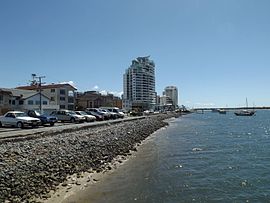Labrador, Queensland
|
Labrador Gold Coast, Queensland |
|||||||||||||
|---|---|---|---|---|---|---|---|---|---|---|---|---|---|

Gold Coast Broadwater foreshore, 2015
|
|||||||||||||
| Population | 16,402 (2011 census) | ||||||||||||
| Postcode(s) | 4215 | ||||||||||||
| LGA(s) | City of Gold Coast | ||||||||||||
| State electorate(s) | Southport, Broadwater | ||||||||||||
| Federal Division(s) | Moncrieff | ||||||||||||
|
|||||||||||||
Labrador is a suburb located on the Gold Coast in Queensland, Australia. At the 2006 Census, Labrador had a population of 15,391, and grew to 16,402 at the 2011 Census. The suburb overlooks the Gold Coast Broadwater to the east and Southport on the southern border.
There are many Aboriginal cultural sites across the Gold Coast. Labrador was part of traditional country for several families, due to the abundance of shell fish, mudcrabs, oysters and waterfowl in the area. The two local peoples most spoken of by the early settlers were the Yugambeh and Kombumerri Aboriginals.
Dawn Rix in her book Labrador - The early pioneers writes that a Scottish Engineer Robert Muir is believed to have named the area in the late 19th century after the a local fishery in north-eastern Canada, owing to the similarities both held in the recreational fishing of streams and the peninsula shape of the land.
Two noteworthy and historical buildings of 1921 were named after the neighbourhood, a residence called Labrador house and the original Labrador State School.
Currently the Gold Coast City Council endorses the Labrador Heritage Walk, and produces a guide booklet which includes twenty one places of historical interest. Three mapped walks have been designed to note the points of interest. Thanks to a collection of preserved photographs at the local studies library in Southport, the booklet is well illustrated.
In April 1878 sugar farmerand investor Robert Muir and investor John Lennon bought 139 acres (0.56 km2) of portion 62 of Crown Land, originally known as Southport North. Portion 62 fronted the Broadwater from Biggera Creek to Broad Street, and the future Billington Street formed part of the western boundary, which continued north until it reached Biggera Creek. The land was surveyed and divided into 19 selections not long after its purchase. When the allotments were sold they were advertised as part of ‘Mr Muir’s Central Southport Estate’. The land overlooked the expanse of the Broadwater and was a good spot for fishing.
...
Wikipedia
